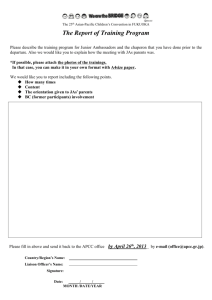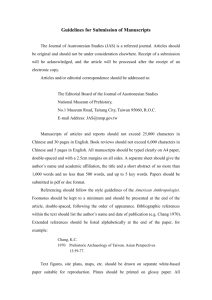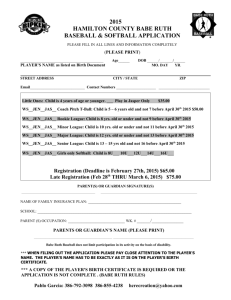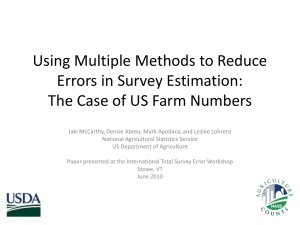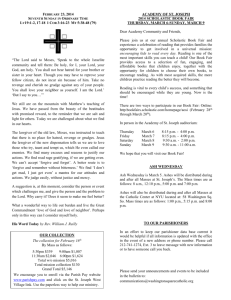k Jonathan P. Pearce, Rajiv T. Maheswaran and Milind Tambe @usc.edu
advertisement
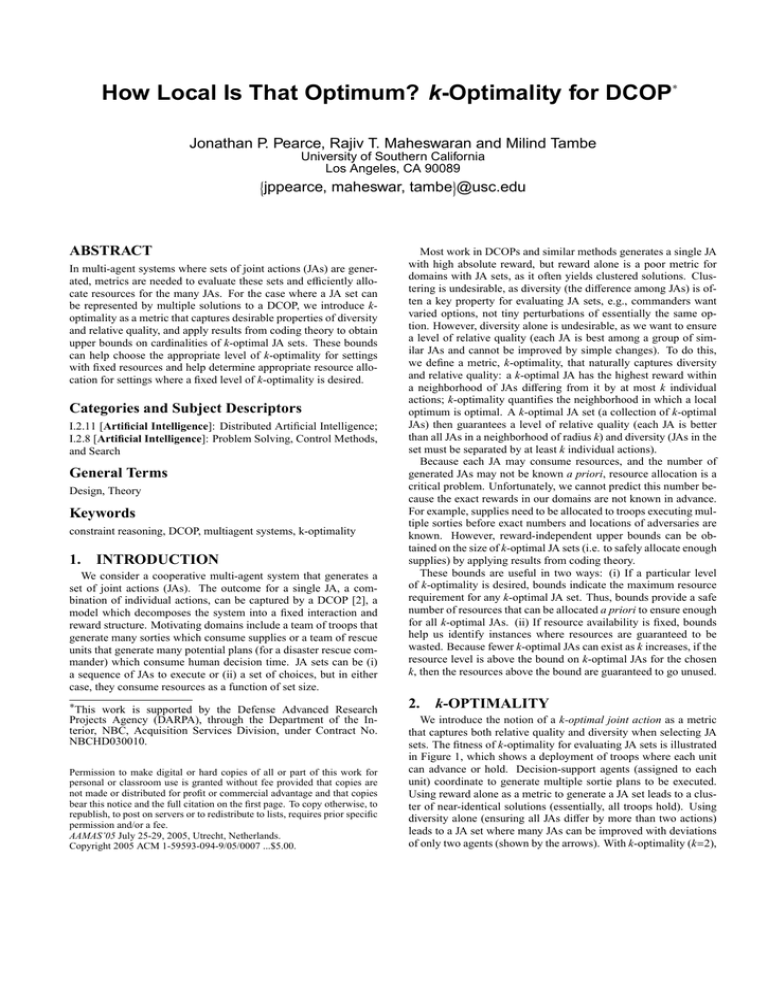
How Local Is That Optimum? k-Optimality for DCOP∗
Jonathan P. Pearce, Rajiv T. Maheswaran and Milind Tambe
University of Southern California
Los Angeles, CA 90089
n
o
jppearce, maheswar, tambe @usc.edu
ABSTRACT
In multi-agent systems where sets of joint actions (JAs) are generated, metrics are needed to evaluate these sets and efficiently allocate resources for the many JAs. For the case where a JA set can
be represented by multiple solutions to a DCOP, we introduce koptimality as a metric that captures desirable properties of diversity
and relative quality, and apply results from coding theory to obtain
upper bounds on cardinalities of k-optimal JA sets. These bounds
can help choose the appropriate level of k-optimality for settings
with fixed resources and help determine appropriate resource allocation for settings where a fixed level of k-optimality is desired.
Categories and Subject Descriptors
I.2.11 [Artificial Intelligence]: Distributed Artificial Intelligence;
I.2.8 [Artificial Intelligence]: Problem Solving, Control Methods,
and Search
General Terms
Design, Theory
Keywords
constraint reasoning, DCOP, multiagent systems, k-optimality
1.
INTRODUCTION
We consider a cooperative multi-agent system that generates a
set of joint actions (JAs). The outcome for a single JA, a combination of individual actions, can be captured by a DCOP [2], a
model which decomposes the system into a fixed interaction and
reward structure. Motivating domains include a team of troops that
generate many sorties which consume supplies or a team of rescue
units that generate many potential plans (for a disaster rescue commander) which consume human decision time. JA sets can be (i)
a sequence of JAs to execute or (ii) a set of choices, but in either
case, they consume resources as a function of set size.
∗This work is supported by the Defense Advanced Research
Projects Agency (DARPA), through the Department of the Interior, NBC, Acquisition Services Division, under Contract No.
NBCHD030010.
Permission to make digital or hard copies of all or part of this work for
personal or classroom use is granted without fee provided that copies are
not made or distributed for profit or commercial advantage and that copies
bear this notice and the full citation on the first page. To copy otherwise, to
republish, to post on servers or to redistribute to lists, requires prior specific
permission and/or a fee.
AAMAS’05 July 25-29, 2005, Utrecht, Netherlands.
Copyright 2005 ACM 1-59593-094-9/05/0007 ...$5.00.
Most work in DCOPs and similar methods generates a single JA
with high absolute reward, but reward alone is a poor metric for
domains with JA sets, as it often yields clustered solutions. Clustering is undesirable, as diversity (the difference among JAs) is often a key property for evaluating JA sets, e.g., commanders want
varied options, not tiny perturbations of essentially the same option. However, diversity alone is undesirable, as we want to ensure
a level of relative quality (each JA is best among a group of similar JAs and cannot be improved by simple changes). To do this,
we define a metric, k-optimality, that naturally captures diversity
and relative quality: a k-optimal JA has the highest reward within
a neighborhood of JAs differing from it by at most k individual
actions; k-optimality quantifies the neighborhood in which a local
optimum is optimal. A k-optimal JA set (a collection of k-optimal
JAs) then guarantees a level of relative quality (each JA is better
than all JAs in a neighborhood of radius k) and diversity (JAs in the
set must be separated by at least k individual actions).
Because each JA may consume resources, and the number of
generated JAs may not be known a priori, resource allocation is a
critical problem. Unfortunately, we cannot predict this number because the exact rewards in our domains are not known in advance.
For example, supplies need to be allocated to troops executing multiple sorties before exact numbers and locations of adversaries are
known. However, reward-independent upper bounds can be obtained on the size of k-optimal JA sets (i.e. to safely allocate enough
supplies) by applying results from coding theory.
These bounds are useful in two ways: (i) If a particular level
of k-optimality is desired, bounds indicate the maximum resource
requirement for any k-optimal JA set. Thus, bounds provide a safe
number of resources that can be allocated a priori to ensure enough
for all k-optimal JAs. (ii) If resource availability is fixed, bounds
help us identify instances where resources are guaranteed to be
wasted. Because fewer k-optimal JAs can exist as k increases, if the
resource level is above the bound on k-optimal JAs for the chosen
k, then the resources above the bound are guaranteed to go unused.
2.
k-OPTIMALITY
We introduce the notion of a k-optimal joint action as a metric
that captures both relative quality and diversity when selecting JA
sets. The fitness of k-optimality for evaluating JA sets is illustrated
in Figure 1, which shows a deployment of troops where each unit
can advance or hold. Decision-support agents (assigned to each
unit) coordinate to generate multiple sortie plans to be executed.
Using reward alone as a metric to generate a JA set leads to a cluster of near-identical solutions (essentially, all troops hold). Using
diversity alone (ensuring all JAs differ by more than two actions)
leads to a JA set where many JAs can be improved with deviations
of only two agents (shown by the arrows). With k-optimality (k=2),
Interaction structure for 8 agents:
(DCOP graph)
1
2
Rewards on edges (two types of edges):
[agent actions:
hold
advance]
3
7
8
4
5
10 0
0 7
6
1 0
0 1
Sample JA sets chosen using three metrics (A, B, C):
(JAs are shown as 1 2 3 4 5 6 7 8 with reward for JA at right)
A. Absolute reward:
43
42
42
41
B. Diversity (d>2):
`
C. k-Optimality (k=2):
43
36
36
31
43
34
18
28
Figure 1: Generating JA sets under various metrics
R
R
12
0
1
23
0
1
0
10
0
0
20
0
1
0
1
2
3
5
1
0
11
Figure 2: DCOP example
we generate a set of diverse JAs (all troops hold; front advances,
rear holds; front holds, rear advances; all advance) where no JA
can be improved with a two-agent deviation.
To define k-optimality more formally, we begin with our model
of the multi-agent team problem. For a set of agents I := {1, . . . , I},
the ith agent takes action ai ∈ Ai . We denote the joint action
of a subgroup
of agents S ⊂ I by aS := ×i∈S ai ∈ AS where
AS :=
i∈S Ai and the joint actions (JAs) of the
entire multiagent team by a = [a1 · · · aI ] ∈ A where A :=
i∈I Ai . The
team reward for taking a particular JA, a, is an aggregation
of the
P
rewards
obtained
by
subgroups
in
the
team:
R(a)
=
R
(a) =
S
S
∈S
P
S ∈S RS (aS ) where S is a minimal subgroup that generates a reward (or incurs a cost) in an n-ary DCOP or cost network (i.e. a
constraint), S is the collection of all such minimal subgroups for
a given problem and RS (·) denotes a function that maps AS to .
By minimality, we mean that the reward component RS cannot be
decomposed further: ∀S ∈ S, RS (aS ) , R1S 1 (aS 1 ) + R2S 2 (aS 2 ) for any
R1S 1 (·) : AS 1 → , R2S 2 (·) : AS 2 → , S 1 , S 2 ⊂ I s.t. S 1 ∪ S 2 = S ,
S 1 , S 2 , ∅. It is important to express the team reward in minimal
form to accurately represent the dependencies and independencies
among agents. Thus, S ⊆ P(I) (where P(·) denotes the power set)
captures these local interactions.
To evaluate JA sets, specifically JAs with respect to each other,
we need notions of neighborhood and distance among JAs. For two
JAs, a and ã, we define the following terms. The deviating group is
D(a, ã) := {i ∈ I : ai , ãi }, the set of agents whose individual actions differ. The distance is d(a, ã) := |D(a, ã)| where |·| denotes the
cardinality
of the set. The relative reward is ∆(a, ã) := R(a)−R(ã) =
P
S ∈S:S ∩D(a,ã),∅ [R(aS ) − R(ãS )] . Given the above, we can now classify a as a k-optimal joint action if ∆(a, ã) > 0 ∀ã s.t d(a, ã) ≤ k.
Every JA can be given a k, identifying the size of the neighborhood
where it is locally optimal. A collection of k-optimal JAs will be
mutually separated by a distance greater than k as they each have
the highest reward within a radius of k. Thus, a higher k-optimality
of a collection implies a greater level of relative reward and diversity. Let Ak = {a ∈ A : ∆(a, ã) > 0 ∀ã s.t d(a, ã) ≤ k} be the set
of all k-optimal JAs. It is straightforward to show Ak+1 ⊆ Ak .
E 1. Figure 2 is a binary DCOP in which agents choose
actions from {0, 1}, with rewards shown for the two constraints
(minimal subgroups) S = {{1, 2}, {2, 3}}. The JA a = [1 1 1] is
1-optimal because any single agent who deviates reduces the team
reward. However, [1 1 1] is not 2-optimal because if the group {2, 3}
deviated, making the JA ã = [1 0 0], team reward would increase
Figure 3: βHS P for all k for systems of up to 10 agents
from 16 to 20. The optimal JA, a∗ = [0 0 0] is k-optimal for all
k ∈ {0, 1, 2, 3}.
3.
BOUNDS ON k-OPTIMA
Bounds on |Ak | can help allocate resources when a particular
level of k-optimality is desired, and can help identify guaranteed
resource waste in fixed-resource settings. To find upper bounds on
the number of k-optimal JAs, we discovered a correspondence to
coding theory [1]. We assume every subgroup G has a unique optimal (subgroup) joint action aG∗ for any context aGC (if G ⊂ I where
G , ∅ and G , I, then ∃ aG∗ ∈ AG s.t. R(aG∗ ; aGC ) > R(aG ; aGC )
for all aG , aG∗ ; GC denotes the complement of set G). Finding
the maximum possible number of k-optimal JAs can be mapped
to finding the maximum number of codewords in a space of qI
words where the minimum distance between any two codewords
is d = k + 1. We can map words to JAs and codewords to k-optimal
JAs as follows: A joint action a taken by I agents each with an action space of cardinality q is analogous to a word of length I from
an alphabet of cardinality q. The distance d(a, ã) can then be interpreted as a Hamming distance between two words. Then, if a is
k-optimal, and d(a, ã) ≤ k, then ã cannot also be k-optimal because
that implies the subgroup D(a, ã) has two optimal (subgroup) joint
actions to the context D(a, ã)C , violating our assumption. Thus, any
two k-optimal JAs must be separated by distance greater than k.
1
Three
Pbk/2cwell-known
I bounds on codewords are Hamming : βH =
I
n
I−k
q / n=0 n (q − 1) , Singleton: βS = q , and Plotkin2 : βP =
k
j
k+1
[1]. Thus, |Ak |, the number of k-optimal JAs for a
k+1−(1−q−1 )I
given I and q, can be bounded by βHS P := min{βH , βS , βP }. For
example, to find a reward-independent bound on 1-optimal JAs for
3 agents with q = 2, (e.g., the system in Figure 2), we obtain βHS P =
4, without knowing R12 and R23 explicitly. If all 1-optimal JAs are
to be executed, each requiring a resource, then the agents must be
equipped with 4 resources to be safe. But, if they are equipped with
more, the extra resources are guaranteed to go unused. Figure 3
shows βHS P for all k for up to 10 agents, with q = 2.
4.
REFERENCES
[1] S. Ling and C. Xing. Coding Theory: A First Course.
Cambridge U. Press, 2004.
[2] P. J. Modi, W. Shen, M. Tambe, and M. Yokoo. Adopt:
Asynchronous distributed constraint optimization with quality
guarantees. Artificial Intelligence, 161(1-2):149–180, 2005.
1
For even k. For odd k, with q = 2, βH (I, k, q) = βH (I − 1, q, k − 1)
can be used to obtain a tighter bound. [1]
2
only valid when (1 − 1/q)n < k + 1
